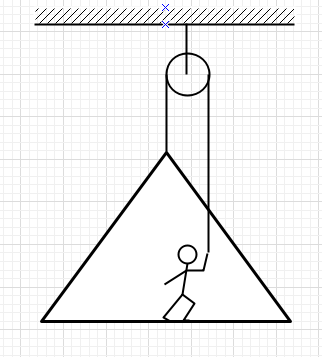Question
Question: A man of mass 50 kg stands on a frame of mass 30kg. He pulls on a light rope which passes over a pul...
A man of mass 50 kg stands on a frame of mass 30kg. He pulls on a light rope which passes over a pulley. The other end of the rope is attached to the frame. For the system to be in equilibrium what force man must exert on the rope?

A. 40×gB. 80×gC. 30×gD. 50×g
Solution
Draw the diagram with the direction of forces for a better understanding. Obtain the total weight on the system and the total tension on the rope. For equilibrium condition, these two forces should be equal. Equate them to find the required solution.
Complete step by step answer:
The mass of the frame is m=30kg
The mass of the man is M=50kg
The man is standing on the frame. So, the total mass of the system is M+m=50kg+30kg=80kg
Now the frame is on a pulley, the other end of the rope is on the hand of the man. The man is pulling the rope to make the system to be in equilibrium.
Let the man is pulling the rope with a force F and the tension on the rope will be T. Again, the frame is also attached to one end of the rope. The weight of the frame is downward. So, we have another tension T on the rope which is also acting upward.
For the system to be in equilibrium, the downward force on the system should be equal to the upward force.
Total downward force m the system will be,
(M+m)g80g
The total upward force will be,
T+T=2T
Now, these two forces will be equal.
2T=80gT=280gT=40g
Since the force with which the man is pulling the rope is equal to the tension on the rope, we can say that the system will be in equilibrium when the man pulls the rope with a force 40×g .
**The correct option is (A).
**
Note:
Pulleys are the simple machines which makes our work easier. Here, we have the rope on both side of the pulley with a downward force on each end. Again, the system is in equilibrium. That’s why we considered the tension on the rope on the both sides of the pulley to be equal.
